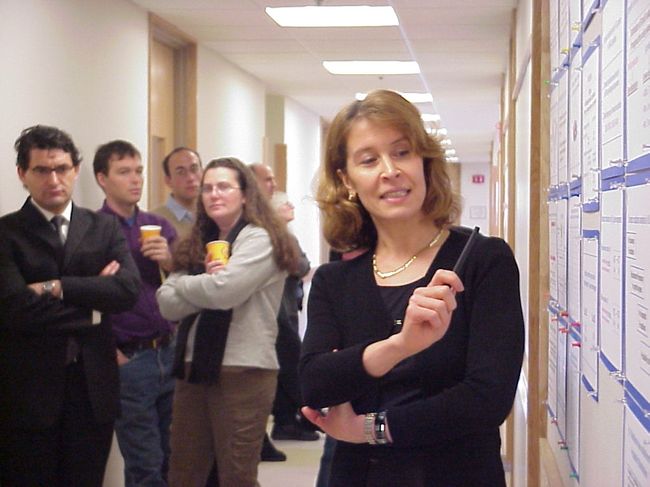AL Amyloidosis
 Basic laboratory research on AL amyloidosis was supported by a “Program Project”, a multi-laboratory grant from the National Heart, Lung, and Blood Institute at the National Institutes of Health. This Program Project supported a team of independent research investigators from diverse science backgrounds in the Departments of Medicine, Pathology, Biochemistry, Biophysics and Environmental Health at the Boston University School of Medicine and School of Public Health. The overall theme of the Program was to understand the structural features of amyloidogenic light chains that permit fibril formation in the tissue microenvironment that lead to amyloid deposition. A major goal of the Program was to develop targeted interventions and bring them to the pre-clinical testing stage. Important projects supported by the program including sequencing and analysis of patient light chain genes, led by Dr. Tatiana Prokaeva and Brian Spencer. Sequences were compiled into ALBase, a publicly available curated database of amyloidogenic and non-amyloidogenic light chains with tools for sequence display and analysis that was set up by Kip Bodi. The Program also supported the development leading up to the first AL transgenic mouse model, published in Blood. Using this model, our investigators, led by Dr. Jennifer Ward, were able to show that the tetracycline antibiotic doxycycline reduces amyloid formation in vivo. A project led by Dr. Martha Skinner, and including Drs. Douglas Sawyer, Lawreen Connors, Carl O’Hara and Vickery Trinkaus-Randall, along with mass spectrometrists Drs. Catherine Costello and Roger Theberge, examined post-translational modifications in the amyloidogenic light chains, their influence on the host tissue, and the physiologic tissue effects caused by the light chains. Dr. David Sherr, the head of the laboratory research program at the BU School of Public Health, carried out preclinical investigation of immunotherapy strategies against amyloidogenic plasma cells. In work led by Dr. Amanda Flies, they showed that the light chains themselves, and plasma cell proteins Blimp-1 and cytochrome p450 1B1 are potential vaccine targets, based upon studies in HLA transgenic mice. This was published in the Nature journal Immunology & Cell Biology in 2012. Drs. Lawreen Connors, Carl O’Hara, and Catherine Costello led the core laboratories that supported the Program.
Basic laboratory research on AL amyloidosis was supported by a “Program Project”, a multi-laboratory grant from the National Heart, Lung, and Blood Institute at the National Institutes of Health. This Program Project supported a team of independent research investigators from diverse science backgrounds in the Departments of Medicine, Pathology, Biochemistry, Biophysics and Environmental Health at the Boston University School of Medicine and School of Public Health. The overall theme of the Program was to understand the structural features of amyloidogenic light chains that permit fibril formation in the tissue microenvironment that lead to amyloid deposition. A major goal of the Program was to develop targeted interventions and bring them to the pre-clinical testing stage. Important projects supported by the program including sequencing and analysis of patient light chain genes, led by Dr. Tatiana Prokaeva and Brian Spencer. Sequences were compiled into ALBase, a publicly available curated database of amyloidogenic and non-amyloidogenic light chains with tools for sequence display and analysis that was set up by Kip Bodi. The Program also supported the development leading up to the first AL transgenic mouse model, published in Blood. Using this model, our investigators, led by Dr. Jennifer Ward, were able to show that the tetracycline antibiotic doxycycline reduces amyloid formation in vivo. A project led by Dr. Martha Skinner, and including Drs. Douglas Sawyer, Lawreen Connors, Carl O’Hara and Vickery Trinkaus-Randall, along with mass spectrometrists Drs. Catherine Costello and Roger Theberge, examined post-translational modifications in the amyloidogenic light chains, their influence on the host tissue, and the physiologic tissue effects caused by the light chains. Dr. David Sherr, the head of the laboratory research program at the BU School of Public Health, carried out preclinical investigation of immunotherapy strategies against amyloidogenic plasma cells. In work led by Dr. Amanda Flies, they showed that the light chains themselves, and plasma cell proteins Blimp-1 and cytochrome p450 1B1 are potential vaccine targets, based upon studies in HLA transgenic mice. This was published in the Nature journal Immunology & Cell Biology in 2012. Drs. Lawreen Connors, Carl O’Hara, and Catherine Costello led the core laboratories that supported the Program.
Current studies continue to examine the anti-amyloid activity of doxycycline analogs in vitro and in the transgenic mouse model, and use human tissue samples and the transgenic mice to explore the role of magnetic resonance imaging (MRI) for visualizing and quantifying amyloid deposits, a collaboration with Dr. James Hamilton (Biophysics & Physiology Department) and Stephan Anderson (Radiology).